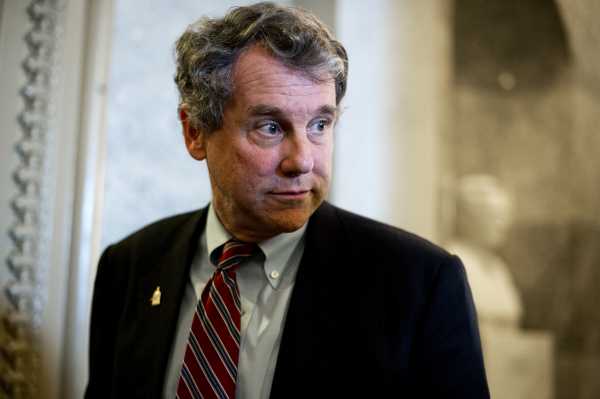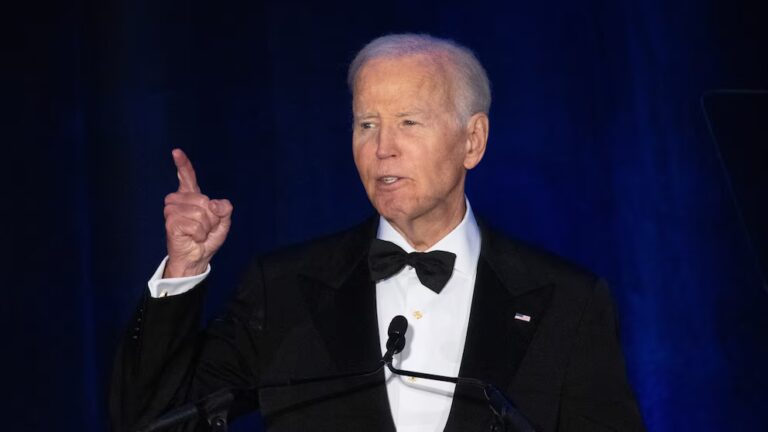
If Democrats have any hope of keeping Ohio competitive and rebuilding the Midwestern blue wall that fell to Donald Trump in 2016, Sherrod Brown needs to win reelection this fall.
“The worry for Brown is that the state has taken a turn toward the Republicans and won’t turn back,” Kyle Kondik, part of the University of Virginia’s Crystal Ball team who quite literally wrote the book on Ohio, told me. “If Brown loses, it’s hard to see how Democrats can really contest the state in 2020 — in fact, they likely wouldn’t even try.”
Ohio swung dramatically toward Republicans in 2016: After President Obama won by 3 percentage points in 2012, Trump beat Hillary Clinton by 8 points. Brown is currently the only Democrat holding statewide elected office in the Buckeye State.
The two-term senator, who was first elected to the Senate in 2006, remains popular in Ohio and might have the right kind of populist persona to play well in this newly minted Trump Country. Brown is still considered a slight favorite to win this November: The UVA Crystal Ball rates the race “Lean Democrat,” as does the Cook Political Report.
Brown’s opponent will be determined in a May 8 primary. Jim Renacci, a Republican congressman looking to capitalize on Trump’s 2016 playbook, and Cleveland businessman Mike Gibbons, who’s running as a political outsider (sound familiar?), are the contestants.
On Tuesday, Renacci got the all-important Trump endorsement.
Whichever Republican emerges to challenge Brown, the stakes in Ohio are ginormous on several levels. First and foremost, if Democrats are to have any hope of taking over the Senate next year, Brown needs to keep his seat. Democrats are defending seats in 10 states that Trump won; Ohio is a big one, a step below the challenges that the party will face in Indiana and Missouri.
On a more fundamental level, the Ohio Senate race will be an important test case of whether Democrats can still contend in the Midwestern, mostly-white states that Obama had won but that fell out from under them in 2016, handing Trump an Electoral College win even as he lost the popular vote.
Why Sherrod Brown has to be considered the favorite in Ohio
The biggest thing Brown has going for him, Kondik said, is Trump.
The backlash against the party currently occupying the White House is one of the bedrocks of American politics. It (almost) always happens. Democrats are already starting midterms (in theory) with an advantage.
Helping matters for Brown is Trump’s deep unpopularity nationwide and his relative unpopularity in Brown’s state (this October post by FiveThirtyEight compiling state approval ratings had Trump five points underwater in Ohio).
“It may sound overly simplistic, but Trump being in the White House is the biggest reason why Brown is favored,” Kondik said. “There’s just a frequent midterm drag that hurts the presidential party and helps the non-presidential one, and that’s exacerbated when the president is unpopular.”
Kondik pointed to data that show Senate incumbents in the out-of-power party have won reelection 91 percent of the time since 1914, when popular elections for Senate seats began.
On the other hand, Ohio presents some natural challenges for Brown, even in the favorable national environment. The Ohio Democratic Party has struggled to build a bench in recent years, with Republicans still favored in the governor’s race despite the national headwinds. The midterm electorate is usually older and whiter — and Trump won big here. A Democrat can’t simply coast to victory in Ohio on an anti-Trump wave.
In the eyes of Ohio Democrats, the 2016 election offered two lessons: First, yes, you have to turn out the Democratic base. But you also have to win over some number of independent voters or Republican-leaning voters, people who voted for Barack Obama in 2012 and Donald Trump in 2016. That is just the Buckeye state’s makeup now.
“Sherrod wins here because Ohioans know that he works hard, he cares about them, and he approaches every issue carefully, intelligently, and with an eye on what’s best for working families. That’s more important to Ohioans than any partisan loyalty,” Justin Barasky, Brown’s campaign manager, said. “He’s got an ability to appeal to voters of all stripes, even a Republican who voted for Trump and may disagree with him on health care because they see him fighting against bad trade deals that have cost our state jobs.”
Brown is the kind of Democrat who could still play well with an electorate that is otherwise turning Trump-y. He is seen as populist, with a blue-collar tinge despite his Yale bachelor’s degree. He has real credibility with the progressive grassroots.
“In terms of his record, progressives nationally and in Ohio have always respected Senator Brown. He usually says and does what he thinks is right,” said Murshed Zaheed, the political director at CREDO Action, a leading grassroots group. “Unlike Donald Trump, Senator Brown is a real populist. He has a record of speaking out against the big banks and Wall Street when it matters.”
Brown, as this Washington Post profile documented, wanted a bigger stimulus package in 2009 and he wants to reinstate the Glass-Steagall Act (a popular progressive litmus test). He has opposed free trade agreements, previously serving as one of the foremost Democratic critics, along with Bernie Sanders, of the Obama administration’s plans for the Trans-Pacific Partnership trade deal.
He flirted briefly after Trump’s election with working with the new president on renegotiating NAFTA and he praised the decision by the Trump administration to impose tariffs on solar panels, washing machines and steel.
It adds up to a candidate, Kondik said, who should fare better in the white, working-class, exurban parts of the state where support for Democrats fell off precipitously in the 2016 election.
“Brown probably has more appeal in eastern Ohio than Hillary Clinton did,” Kondik explained, “and clawing back voters in Youngstown, Warren, Steubenville, etc. is crucial for a Democrat to win statewide.”
Even Republicans in the state (begrudgingly) respect Brown’s deftness with his populist message.
“He presents himself as this populist in the state. It’s very effective,” one top GOP operative in the state, who requested anonymity to speak candidly about the race, said. “He’ll have this message that’s populist and appeals to the Trump/Bernie voters.”
Brown doesn’t quite have a blank check from progressive activists, however, to do whatever he needs to do in a reddening state.
The first 2018 government shutdown sent up a red flag for the national grassroots. After Senate Democrats shuttered the federal government to force a resolution to the fight over the Deferred Action for Childhood Arrivals program, they stood down a few days later without, in the eyes of the grassroots, making any substantive progress, in a sacrifice of the moral high ground from which the shutdown started.
It was a capitulation, as the progressives sees it, and Brown voted for it. (He told reporters afterward that Democrats hadn’t caved and that he would never cave.)
“I think what he did yesterday was a mistake. To go along with Senator Schumer’s sellout was confusing and disappointing,” Zaheed said. “We just hope yesterday’s vote was an aberration and not an indication that Brown will be tacking to the center this year to win a general election.”
The messy Ohio Republican Senate primary, explained
Brown seemed set for a rematch of his 2012 race against state treasurer Josh Mandel. But the campaign changed dramatically when the Ohio treasurer said in January that he would drop out of the race because of his wife’s health problems. While Brown had already beaten the Republican by six points in 2012, Mandel was a candidate who had won statewide races twice.
Without him, the Republican cupboard was suddenly bare. The best candidates have congregated in the governor’s race, where the current Lt. Gov Mary Taylor and state Attorney General Mike DeWine are the top GOP contenders. The only other announced Senate candidate at the time of Mandel’s withdrawal was Mike Gibbons, a Cleveland-area investment banker who has never held political office. The Washington Examiner described Gibbons as running as “an ideologically flexible political outsider in the mold of President Trump.”
The conservative outlet portrayed the Gibbons campaign’s outlook this way: “Trump proved that there was a market for an outsider who spoke bluntly against the system and prioritized reform over fidelity to conservatism.” The businessman can also afford to bankroll a substantial part of his part of his campaign if need be.
“I’ve actually hired people, I’ve actually started businesses, and I’ve taken the risks that businessmen take,” Gibbons told the Cleveland Plainer Dealer when announcing his candidacy. “Everyone’s yelling ‘jobs, jobs, jobs,’ and they don’t have the foggiest idea of how to create jobs.”
As an outsider candidate pretty explicitly in the Trump mold, in a state where Trump just cruised to victory, Gibbons can’t be ruled out.
“Do not write off Gibbons, either — he was making headway before Mandel dropped out,” Kondik told me, “and the idea of a conservative businessman and political rookie winning a GOP statewide nomination is far from unprecedented.”
The rest of the Republican Party hasn’t been content to let Gibbons simply take the GOP nomination by default, though.
Senate Republican leader Mitch McConnell reportedly discussed a bid with J.D. Vance, who wrote the part-memoir, part-sociological text Hillbilly Elegy which described his upbringing in Appalachian Ohio. The book became a cultural touchstone, particularly among political professionals in Washington from both parties, after Trump’s unexpected victory.
McConnell would have made Ohio a priority if Vance ran, Politico reported, but the author announced, however, that he would not run for the Senate, dashing the hopes of the DC intelligentsia.
That leaves Renacci, who announced after Mandel dropped out he would enter the Senate campaign rather than pursuing the governor’s house. He has served in a district covering northeastern Ohio since 2011.
Renacci is explicitly tying himself to Trump. He said the White House called him shortly before he jumped into the Senate, urging him to run. He is already noting that he endorsed Trump over Kasich during the 2016 Republican presidential primary.
“The president knows that I’ve supported his agenda from then all the way through today,” he said recently on Fox News. ”The president wants to help me with this race.”
He faced an early test in that same interview, the day after Trump called African nations “shithole” countries during an immigration meeting with a bipartisan group of senators. Renacci found a way to explain away the president’s comments in a preview of the race he is likely to run.
“I’ve said all along, the president says what many people are thinking. … That’s a business guy going into a political career. It’s difficult. I know it’s difficult for the president,” he said. “Judge the president after four years, after what we’ve done. Let’s not judge the president by what he says.”
Renacci has also faced questions since he became the presumptive GOP frontrunner about some political contributions that he made as a registered lobbyist. But he still has Trump’s backing, after the president’s tweet on Tuesday.
So that is the Republican primary shaping up: The House conservative who wants to embrace Trump and the political outsider who actually is a lot like Trump. It’s too soon to say who will prevail or who would pose the biggest challenge for Brown.
“Depending on who emerges, it’s possible that person would give Brown more trouble than Mandel would have, but it’s also possible that Brown could coast if Republicans decide they have better options elsewhere on a big map,” Kondik said. “So I’d say the Mandel move widened the range of possibilities for the race while not really improving or hurting Brown’s overall chances, at least in the short term.”
As the race heads into November, Sherrod Brown will hold Democratic hopes for keeping the Buckeye state competitive in his hands.
Sourse: vox.com






